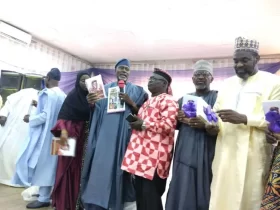Driven by the Aristotelian theory of mimesis, which perceives art as an imitation of life, the award- winning literary artist, Tubal Cain, in his latest work dissects the hydra-headed problems afflicting a nation in transition. The utilitarian dimension of the author’s work, the functional relevance of his chosen themes, the remarkable literary artistry of his style and the sheer communicative competence underpinning his diction all combine to project Tubal Cain as a great artist. As a matter of fact, when Aristophanes, the classical comedian in his play, The Frogs, posits that from the earliest of times, the greatest of poets/ writers is that who has a lesson to teach his people, he could as well be referring to this talented winner of the 2006 Association of Nigerian Authors/ Gabriel Okara Prize for poetry. An accomplished prose writer too, it is in the light of the afore-said and a careful excursion into the work that Dandaula and Other African Tales (simply DOAT) can be appreciated as further grist to mill of the growing African literature of the sociological theoretical bent.
The book under review is a collection of twelve short stories that powerfully position the author in the light of Georg Lukas’ conception of a writer: ‘a son of his own age’. In these stories, Tubal Cain probes, sometimes deeply, sometimes peripherally, into the plethora of contemporary social crises ensnaring the ‘fumbling and bumbling’ Nigerian nation, the Niger Delta as its microcosm, and Africa at large, in its morbid quest for cevilization. At the end of the day, what is presented to the reader is a sumptuous buffet from which various categories of people can find their appropriate food for thought, not just food for palate. From hostage-taking fad among the restive and ubiquitous Niger Delta groups to the depletion of the flora and fauna of the coastal areas through the exploration of oil and its concomitant pauperization of the people, from the shenanigans of the religious bigots to the pervert antics of the political class, from pervasive prostitution to brazen-faced armed robbery, from the prevalent internecine wars to the miscarriage of justice, from sheer man’s inhumanity to man to unbridled moral anarchy, nothing seems to escape our writer’s critical scrutiny of the socio-political topography of the African continent.
The first story presents the tragedy of human predicament. The only source of livelihood, “The Palm Tree” that the narrator’s poor father left for him at death wilts away due to oil spillage, his whole family wiped away by the joint military task force, forcing him justifiably to take recourse in joining one of the violent liberation movements. The author moralizes the youth, at the end of the story, that the solution to the Niger Delta problems does not lie in sabotage or hostage-taking. It rather lies in education through which the youth can develop themselves and their communities, rather than taking violent and often counter-productive measures. This theme is further amplified in the tenth story, “The Soothsayer’s Warning” where the incursion of foreigners with their alcoholic, tobacco and oil companies results in abysmal social dislocation. Men abandon work on the oil-depleted farmlands to earn miserable wages, women become strip dancers and prostitutes for quick money while frustration, suicide and alcoholic addiction thus hold the community in the jugular, as the compromised leaders look the other way, bought, detached and unperturbed.
In the second story, “The Ancient Oath” (or path), the author decries the exploitation of religion by the politicians to achieve their selfish ends. A prosperous community that would ordinarily choose its leaders by merit is visited by natural disasters that it finds appropriate local solutions to. The infiltration of what is branded as “foreign religions”, Christianity and Islam, eventually polarizes the people making them exploitable by political agitators who use religion to divide people. The community eventually breaks up as a result of drought and it is the surviving skeletal figures that tell the dispersed indigenes that the solution to their problems lies in religious tolerance, a relevant antidote to Nigeria and her volatile political and religious intransigence. The theme of religion is further advanced, though in a different dimension, in “The Greatest Law”, the fifth story that narrates the travails of three missionaries who get ‘imprisoned’ by hardened jailbirds in an abandoned factory. The message of the story is crystal clear: religious commitment does not insulate one from terrible challenges, it is only gratifying that, as it happens in the story, there will always be a way out for the faithful as God does not abandon His own in the long run.
What draws the attention of the writer in the third story is a tripodal sociological problem that permeates the Nigerian society: women, betrayal and travesty of justice. These three are intricately woven in “The Tryst”, one of the best plotted stories in the collection. A physically challenged accounts clerk, Abba who doubles as the narrator, is in love with a local belle, Safinatu. His business rival, Aliyu, succeeds in blackmailing him and the girl also betrays his love by moving in with Aliyu. A drunken gambler, Aliyu is a pathetic sight on the street on a fateful morning and the compassionate Abba comes to his rescue, taking him to his own (Abba’s) house and feeding him. He only returns from work to find Aliyu’s dangling body in his house with a suicide note! Abba becomes a prisoner, disowned by his father for dragging family name in the mud and is excluded from family patrimony – a multiple calamity. He becomes a complete wreck all because of loving a wrong woman. Another story with a related theme, though of inferior aesthetic quality, is the penultimate story, “Cerulean Waltz”. A typical le femme fatale story, a young man, Johnson decides to have a fling with a strange woman that claims she is stranded. After a night of passion, Johnson wakes up to find a monstrous creature, an alligator, instead of the woman on his bed. His cries of alarm draw the attention of the neighbours who besiege and kill the woman-turned-alligator. The consequence is cataclysmic: the lover-boy turns deaf and dumb, loses his job and becomes a destitute just as a nude painting indiscretion on the part of a Brother Henry leads him to a tragic death in the hands of his fair complexioned lady-customer in the last story, “The Cleavage”. The three stories are very crucial and instructive to men especially in our x-rated, sextoxicated world of today.
The collection is named after the longest and fourth story, “Dandaula” which presents a cultural conflict in a way reminiscent of Chinua Achebe’s No Longer at Ease. A poor rural Fulani community deifies the python and a family member of a victim of snakebite assumes healing and metaphysical powers. After a failed attempt by Dandaula to resist the census to be conducted on his village fails, he agrees to the arrangement of head-count by the authorities. The day of the head-count becomes tragic as the python fatally bite the census officials. The government reacts by deploying policemen to raid and loot the erstwhile peaceful community with the story leaving several questions unanswered. This can be contradistinguished from an interestingly topical story, “The Forest of Tarida”, the ninth in the collection. Here, the obnoxious practice of child marriage that features in some Nigerian societies is thematized. After violating young girls and causing them intense pains and incurable diseases, such girls are banished into the evil forest to rot and die in hunger and privation. A bold attempt by the social outcasts to reveal their plight to the world during a communal festive event becomes tragic. Rather than allow the foreigners to help the unfortunate women of the forest of Tarida, the federal government in the pretext of investigating the issue wipes the population out completely to avoid embarrassment. Even the journalist and the editor of the newspaper that reveal the massacre become victims of premeditated murders disguised as armed robberies. The theme of man’s inhumanity to man unites these two stories.
The remaining stories are, “Destiny”, “The Blight” and “The Ghost Song”, which are the sixth, seventh and eighth stories respectively. Apart from the title that doesn’t correlate with the story, “Destiny” appears to be the weakest story in the collection with the drab story of an eventually arrested criminal (in, of all places, a police station) that changes sex, from male to female, then female to male, to cover his tracks, a very incongruous phenomenon in the African setting. The story following it highlights the affliction of a community with a terrible disease, of HIV/AIDS proportion, which however does not prevent the victims from being victorious in the war against their community. The eighth story recreates the impressions Africans had of the European missionaries as ghosts in the early days of their evangelical activities. The ‘ghosts’ that are being hunted eventually rescue the twins of the Obong (traditional ruler) that are to be cast into the river as tradition required, thereby warming themselves to the heart of the Obong, such that the village community led the Obong visits them monthly with foodstuff, fanfare, drumming and dancing to the ‘ghost song’.
In essence, Tubal Cain deserves our commendation for placing a delicious literary menu on our table. The profundity of the themes examined will commend the work to all those who are interested in the contemporary sociology of Africa. The subtle homilies and the indirect clarion calls of dropping the metal and picking the petal that saturate the work will especially make it relevant to the youth, the future leaders of the continent. It is a book that should be read by secondary school students and students of tertiary institutions across Africa, starting from Nigeria. The book only could have benefited from the services of a competent copy editor or even a good proof-reader who would have handled instances of grammatical and mechanical infelicities that percolate the book hence detracting from its quality. The production too could have been made better done by a more professional publisher who would not focus on the cover page alone at the expense of the body of the work.
Book: Dandaula and Other African Tales (DOAT)
Author: Tubal Cain
Publisher: Precious Styles (Nig.) Ltd.
Reviewer: Mahfouz A. Adedimeji
Date: 2007
Pages: 124.





Leave a Reply